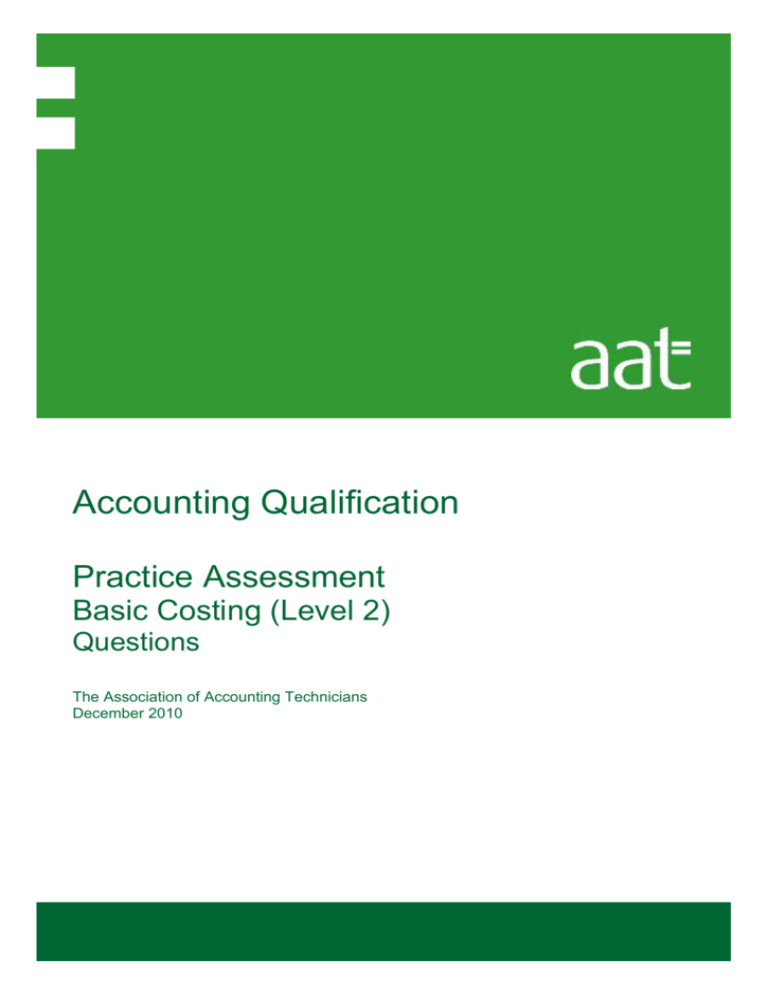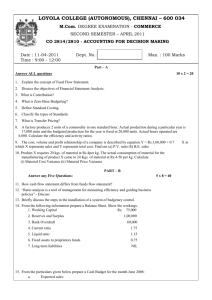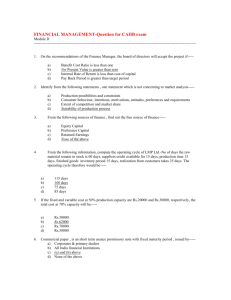Practice Paper – Basic Costing
advertisement

Accounting Qualification Practice Assessment Basic Costing (Level 2) Questions The Association of Accounting Technicians December 2010 Time allowance: 2 hours Section 1 Task 1.1 The table below lists some of the characteristics of financial accounting and management accounting systems. Indicate two characteristics for each system by putting a tick in the relevant column of the table below. Financial Accounting Characteristic It is based on past events Its purpose is to provide information for managers It is based on future events It complies with company law and accounting rules BCCG (Level 2) – Practice Questions 2 Management Accounting Task 1.2 Olsen Ltd is a manufacturer of garden furniture. Classify the following costs by element (materials, labour or overheads) by putting a tick in the relevant column of the table below. Cost Materials Wood used in garden chairs Rent of factory Wages of carpenters in the cutting department Expenses of the office manager BCCG (Level 2) – Practice Questions 3 Labour Overheads Task 1.3 Curly Ltd is in business as hairdressers. Classify the following costs by nature (direct or indirect) by putting a tick in the relevant column of the table below. Cost Direct Conditioner used on hair Insurance of salon Wages of salon cleaner Wages of hair stylists BCCG (Level 2) – Practice Questions 4 Indirect Task 1.4 Greenside Ltd produces chocolate products. Classify the following costs by function (production, administration, or selling and distribution) by putting a tick in the relevant column of the table below. Cost Production Purchases of sugar Depreciation of sales department’s motor vehicles Insurance of office furniture Salaries of production workers BCCG (Level 2) – Practice Questions 5 Administration Selling and Distribution Task 1.5 Fairway Ltd is a manufacturer of clothes. Classify the following costs by their behaviour (fixed, variable, or semi-variable) by putting a tick in the relevant column of the table below. Cost Fixed Material used in the production process Advertising budget for the year Electricity costs which include a standing charge Labour costs paid on a piecework basis BCCG (Level 2) – Practice Questions 6 Variable Semivariable Task 1.6 Olsen Ld, a manufacturer of garden furniture, uses a numerical coding structure based on one profit centre and three cost centres as outlined below. Each code has a sub-code so each transaction will be coded as ***/*** Profit/Cost Centre Sales Code 100 Production Administration Selling and Distribution 200 300 400 Sub-classification Sub-code UK Sales 100 Overseas Sales 200 Direct Cost 100 Indirect Cost 200 Direct Cost 100 Indirect Cost 200 Direct Cost 100 Indirect Cost 200 Code the following revenue and expense transactions, which have been extracted from purchase invoices, sales invoices and payroll, using the table below. Transaction Office Heating Warehouse Rent Sales to Oxford, UK Sales to North America Materials to stain tables Factory canteen wages BCCG (Level 2) – Practice Questions Code 7 Task 1.7 Curly Limited operates a hairdressing salon and uses a coding system for its elements of cost (materials, labour or overheads) and then further classifies each element by nature (direct or indirect cost) as below. So, for example, the code for direct materials is A100. Element of Cost Materials Labour Overheads Code A B C Nature of Cost Code Direct 100 Indirect 200 Direct 100 Indirect 200 Direct 100 Indirect 200 Code the following costs, extracted from invoices and payroll, using the table below. Cost Code Salary of trainee hairdresser Legal costs to renew lease of salon Wages of salon cleaner Cleaning materials used by cleaner Colouring materials used on customers BCCG (Level 2) – Practice Questions 8 Task 1.8 Identify the following statements as either true or false by putting a tick in the relevant column of the table below. True Variable costs change directly with changes in activity Fixed costs change directly with changes in activity Semi-variable costs have a fixed and variable element BCCG (Level 2) – Practice Questions 9 False Task 1.9 Classify the following costs as either fixed or variable by putting a tick in the relevant column of the table below. Costs Direct Materials Wages of production workers paid using a time-rate method Wages of production workers paid by a piece rate method Rent for a factory used for production BCCG (Level 2) – Practice Questions Fixed 10 Variable Task 1.10 Complete the table below showing fixed costs, variable costs, total costs and unit cost at the different levels of production. Units Fixed Costs Variable Costs Total Costs Unit Cost 1,000 £12,000 £3,000 £15,000 £15 2,000 £ £ £ £ 3,000 £ £ £ £ 4,000 £ £ £ £ BCCG (Level 2) – Practice Questions 11 Task 1.11 Olsen Ltd is costing a single product which has the following cost details: Variable Costs per unit Materials Labour Total Fixed Costs £2 £3 £80,000 Complete the following total cost and unit cost table for a production level of 20,000 units. Element Total Cost Unit Cost Materials £ £ Labour £ £ Overheads £ £ Total £ £ BCCG (Level 2) – Practice Questions 12 Task 1.12 Ironside Ltd makes a single product and for a production level of 24,000 units has the following cost details: Materials Labour Overheads 6000 kilos 8000 hours at £20 per kilo at £12 an hour £48,000 Complete the table below to show the unit cost at the production level of 24,000 units. Element Unit Cost Materials £ Labour £ Overheads £ Total £ BCCG (Level 2) – Practice Questions 13 Section 2 Task 2.1 Reorder the following costs into a manufacturing account format on the right side of the table below for the year ended 31 December. £ £ Closing Stock of Work in Progress 10,000 Direct Labour 97,000 Opening Stock of Raw Materials 7,000 Closing Stock of Finished Goods 25,000 Closing Stock of Raw Materials 10,000 Manufacturing Overheads 53,000 Cost of goods sold 200,000 Factory cost 197,000 Purchases of Raw Materials 50,000 Opening Stock of Work in Progress 8,000 Opening Stock of Finished Goods 30,000 Prime cost 144,000 Direct materials used 47,000 Factory cost of goods manufactured 195,000 BCCG (Level 2) – Practice Questions 14 Task 2.2 Identify the correct stock valuation method from the characteristic given by putting a tick in the relevant column of the table below. Characteristic FIFO Issues are valued at the most recent purchase cost Stock is valued at the average of the cost of purchases Stock is valued at the most recent purchase cost BCCG (Level 2) – Practice Questions 15 LIFO AVCO Task 2.3 Identify whether the following statements are true or false by putting a tick in the relevant column of the table below. True FIFO costs issues of stock at the most recent purchase price AVCO costs issues of stock at the oldest purchase price LIFO costs issues of stock at the oldest purchase price FIFO values closing stock at the most recent purchase price LIFO values closing stock at the most recent purchase price AVCO values closing stock at the latest purchase price BCCG (Level 2) – Practice Questions 16 False Task 2.4 Olsen Ltd has the following movements in a certain type of stock into and out of its stores for the month of March: Date Receipts Units Issues Cost Units March 5 200 £600 March 8 300 £1,200 March 12 500 £2,500 March 18 Cost 600 March 25 400 £2,400 Complete the table below for the issue and closing stock values. Method Cost of Issue on 18 March Closing Stock at 31 March FIFO £ £ LIFO £ £ AVCO £ £ BCCG (Level 2) – Practice Questions 17 Task 2.5 Identify the following statements as true or false by putting a tick in the relevant column of the table below. True Direct labour costs can be identified with the goods being made or the service being produced Indirect costs vary directly with the level of activity BCCG (Level 2) – Practice Questions 18 False Task 2.6 Identify the labour payment method by putting a tick in the relevant column of the table below. Payment Method Time-rate Labour is paid based on the production achieved Labour is paid extra if an agreed level of output is exceeded Labour is paid according to hours worked BCCG (Level 2) – Practice Questions 19 Piecework Time-rate plus bonus Task 2.7 Identify one advantage for each labour payment method by putting a tick in the relevant column of the table below. Payment Method Time-rate Assured level of remuneration for employee Employee earns more if they work more efficiently than expected Assured level of remuneration and reward for working efficiently BCCG (Level 2) – Practice Questions 20 Piecework Time-rate plus bonus Task 2.8 Greenside Ltd pays a time-rate of £10 per hour to its direct labour for a standard 35 hour week. Any of the labour force working in excess of 35 hours is paid an overtime rate of £15 per hour. Calculate the gross wage for the week for the two workers in the table below. Worker Hours Worked Basic Wage Overtime Gross Wage A. Singh 35 hours £ £ £ S. Callaghan 40 hours £ £ £ BCCG (Level 2) – Practice Questions 21 Task 2.9 Olsen Ltd uses a piecework method to pay labour in one of its factories. The rate used is 80p per unit produced Calculate the gross wage for the week for the two workers in the table below. Worker Units Produced in Week G Patel 300 units £ A Jones 400 units £ BCCG (Level 2) – Practice Questions 22 Gross Wage Task 2.10 Olsen Ltd uses a time-rate method with bonus to pay its direct labour in one of its factories. The time-rate used is £12 per hour and a worker is expected to produce 5 units an hour. Anything over this and the worker is paid a bonus of £1 per unit. Calculate the gross wage for the week including bonus for the three workers in the table below. Hours Worked Units Produced A Smith 35 150 £ £ £ J O’Hara 35 175 £ £ £ M Stizgt 35 210 £ £ £ Worker BCCG (Level 2) – Practice Questions Basic Wage 23 Bonus Gross Wage Task 2.11 Identify the following statements as being true or false by putting a tick in the relevant column of the table below. True A variance is the difference between budgeted and actual cost A favourable variance means budgeted costs are greater than actual costs BCCG (Level 2) – Practice Questions 24 False Task 2.12 Greenside Ltd has produced a performance report detailing budgeted and actual cost for last month. Calculate the amount of the variance for each cost type and then determine whether it is adverse or favourable by putting a tick in the relevant column of the table below. Cost Type Budget £ Actual £ Direct Materials 38,400 40,100 £ Direct Labour 74,200 73,000 £ Production Overheads 68,000 72,100 £ Administration Overheads 52,000 54,900 £ 41,900 £ Selling and Distribution Overheads 43,000 BCCG (Level 2) – Practice Questions Variance 25 Adverse Favourable Task 2.13 The following performance report for this month has been produced for Greenside Ltd as summarised in the table below. Any variance in excess of 10% of budget is thought to be significant and should be reported to the relevant manager for review and appropriate action. Examine the variances in the table below and indicate whether they are significant or not significant by putting a tick in the relevant column. Cost Type Budget Variance Adverse/ Favourable Direct Materials £39,000 £3,300 A Direct Labour £75,000 £8,000 A Production Overheads £69,000 £4,200 F Administration Overheads £53,000 £5,900 A Selling and Distribution Overheads £41,000 £2,100 A BCCG (Level 2) – Practice Questions 26 Significant Not Significant Task 2.14 It was noted from the performance report for Greenside Ltd for an earlier month that the following cost variances were significant: Direct Labour Cost Administration Overheads These variances needed to be reported to the relevant managers for review and appropriate action if required. Select from the following list a relevant manager for each significant variance to whom the performance report should be sent: HR Manager Production Manager Administration Manager Variance Manager Direct Labour Cost Administration Overheads BCCG (Level 2) – Practice Questions 27







